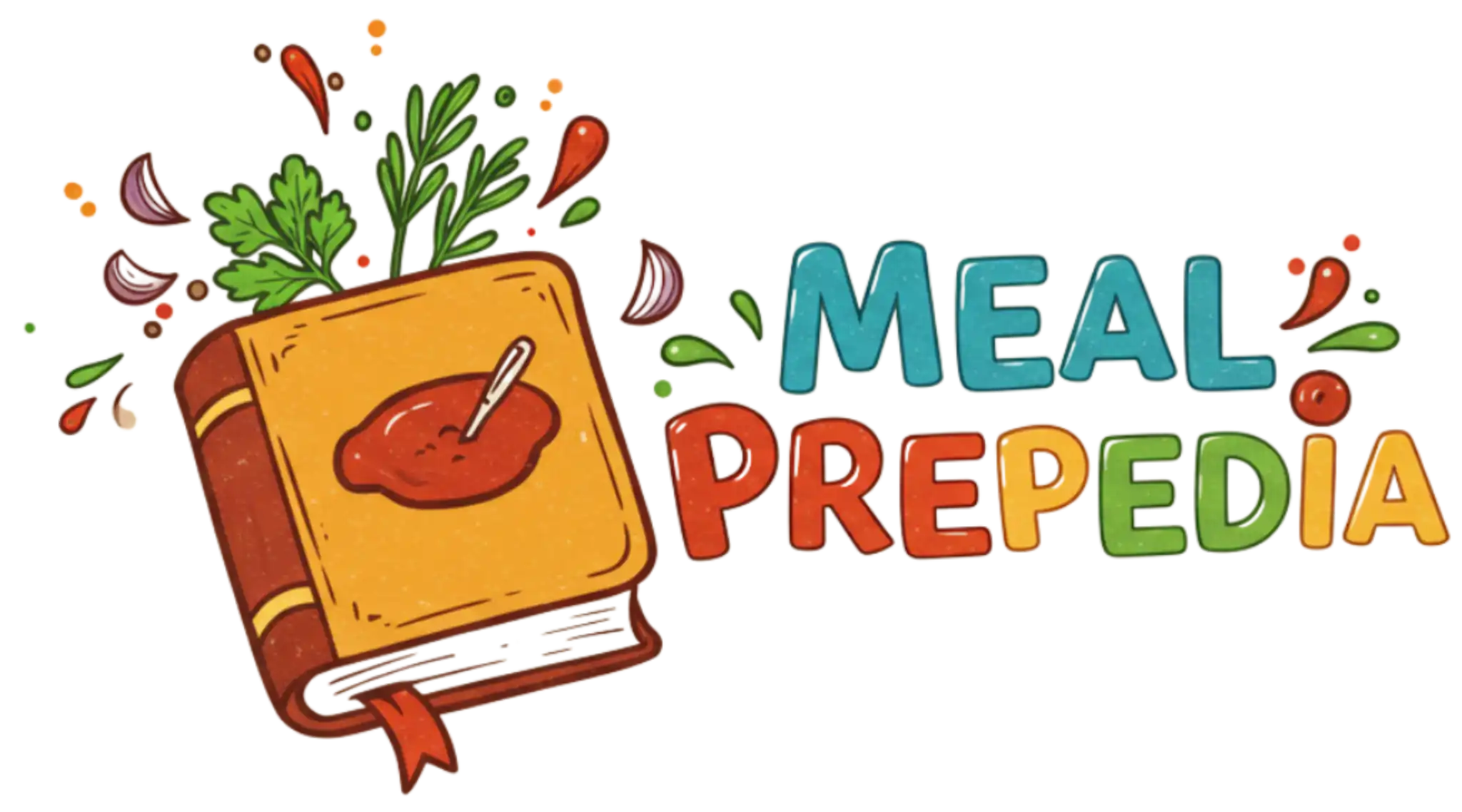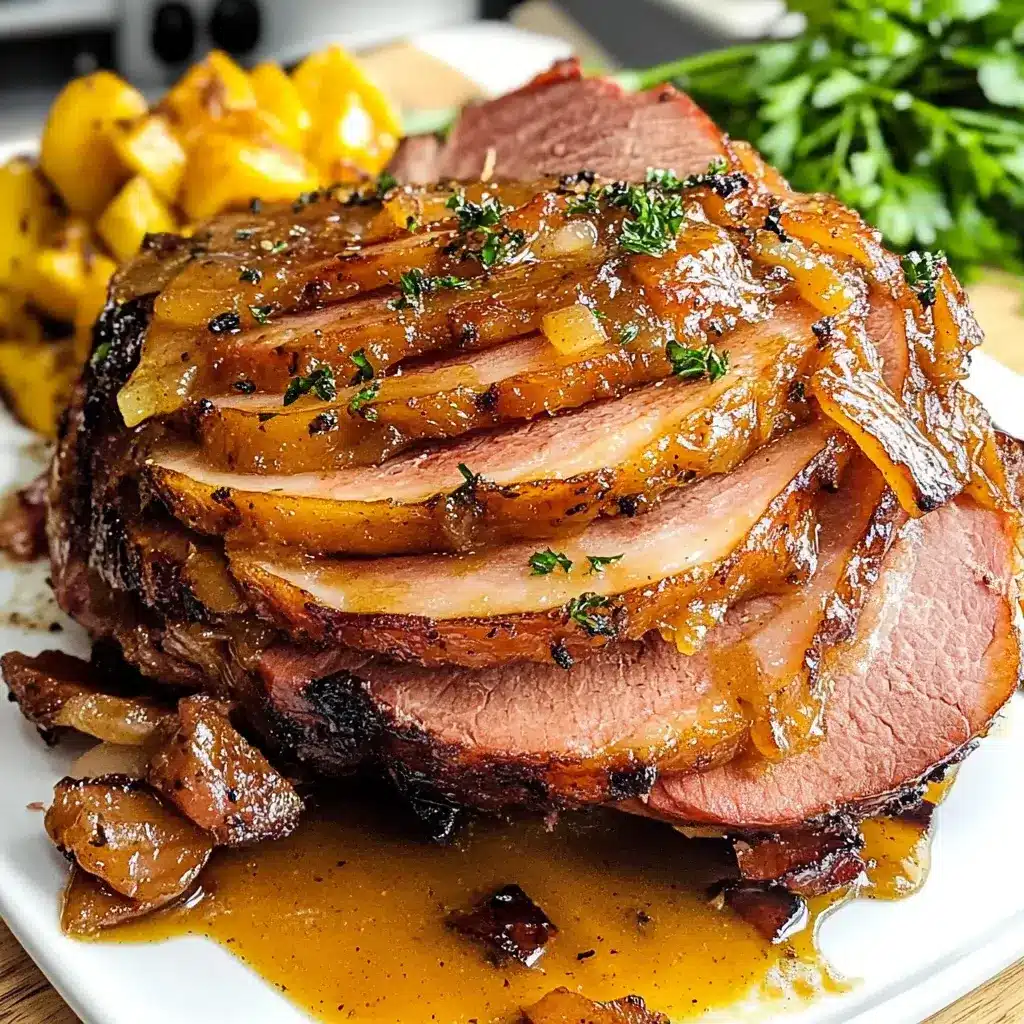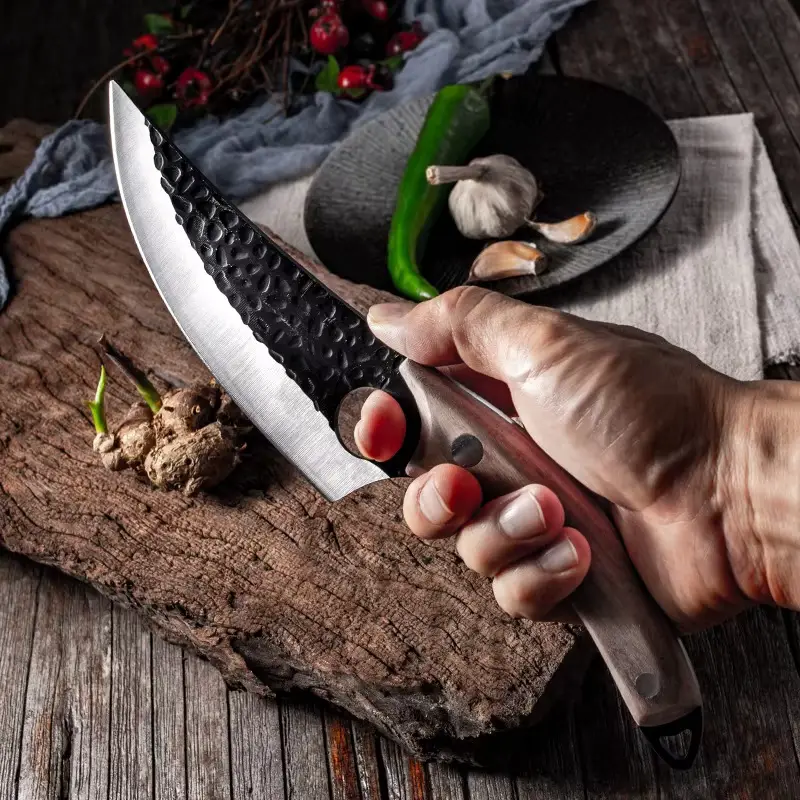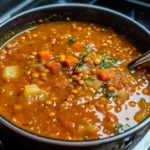Every holiday season, our family kitchen transforms into a bustling hub of delicious aromas and joyful chatter. But amidst all the festive chaos, there’s always one dish that steals the show – the Maple Mustard Ham. It all started a few years ago when I stumbled upon this recipe, searching for something a little different from our usual honey-glazed ham. Let me tell you, it was a game-changer! The first bite was an explosion of flavors – the rich, savory ham perfectly balanced by the sweet, tangy glaze. The maple syrup and Dijon mustard create this magical harmony that’s both comforting and exciting. From the moment it came out of the oven, glistening and fragrant, everyone was hooked. The kids, who can sometimes be picky eaters, devoured it. My parents raved about the depth of flavor. And my partner declared it the best ham he’d ever tasted. Since then, Maple Mustard Ham has become a non-negotiable part of our holiday feasts. It’s incredibly easy to make, yet delivers a restaurant-quality taste that impresses every single time. If you’re looking for a centerpiece dish that will wow your family and friends and become a cherished tradition, look no further. This Maple Mustard Ham recipe is it. Get ready for compliments and requests for seconds… and thirds!
Ingredients
- Bone-in or Boneless Ham (8-10 pounds): The heart of the recipe. Choose a good quality, fully cooked ham. Bone-in hams tend to be more flavorful, while boneless hams are easier to carve.
- Pure Maple Syrup (1 cup): The natural sweetener that provides that signature maple flavor and beautiful glaze. Ensure it’s pure maple syrup for the best taste, not pancake syrup.
- Dijon Mustard (1/2 cup): Adds a tangy, sharp counterpoint to the sweetness of the maple syrup, creating a complex and balanced flavor profile.
- Brown Sugar (1/4 cup, packed): Enhances the sweetness and contributes to a richer, caramelized glaze texture. Light or dark brown sugar works well.
- Apple Cider Vinegar (2 tablespoons): Provides a touch of acidity that cuts through the richness of the ham and glaze, adding brightness and depth.
- Garlic Powder (1 tablespoon): Infuses a subtle savory garlic note into the glaze, complementing the other flavors without being overpowering.
- Onion Powder (1 teaspoon): Adds a mild oniony undertone that enhances the overall savory complexity of the glaze.
- Ground Cloves (1/2 teaspoon): A warm, aromatic spice that beautifully complements maple and ham, adding a touch of festive warmth and depth.
- Water or Pineapple Juice (1 cup): Used in the bottom of the roasting pan to create steam and keep the ham moist during baking, preventing it from drying out. Pineapple juice adds a subtle sweetness that pairs well with the glaze.
- (Optional) Fresh Rosemary or Thyme Sprigs: For an aromatic garnish. Fresh herbs add a lovely visual appeal and a subtle herbal note to the finished ham.
Instructions
- Preheat Your Oven and Prepare the Ham: Preheat your oven to 325°F (160°C). This moderate temperature ensures the ham cooks through gently without drying out and allows the glaze to caramelize beautifully. While the oven is preheating, prepare your ham. Place the ham on a large cutting board. If your ham has a thick rind, you may want to trim some of it off to allow the glaze to penetrate better. However, leaving some rind on can help retain moisture.
- Score the Ham for Flavor Penetration: Using a sharp knife, score the surface of the ham in a diamond pattern. Make shallow cuts, about ¼ to ½ inch deep, across the top of the ham. Then, rotate the ham and make another set of cuts diagonally to create the diamond pattern. Scoring serves two important purposes: First, it creates more surface area for the delicious maple mustard glaze to adhere to and penetrate the ham, infusing it with flavor throughout. Second, it allows fat to render out during cooking, resulting in a more flavorful and less fatty final product. Visually, the scored pattern also looks beautiful after glazing and baking, adding to the presentation.
- Whisk Together the Magnificent Maple Mustard Glaze: In a medium-sized bowl, prepare the star of the show – the Maple Mustard Glaze. Combine the pure maple syrup, Dijon mustard, brown sugar, apple cider vinegar, garlic powder, onion powder, and ground cloves. Whisk all these ingredients together thoroughly until they are completely combined and the brown sugar is dissolved into the mixture. Taste the glaze – it should be a harmonious blend of sweet, tangy, and savory. The maple syrup provides the primary sweetness, balanced by the sharpness of the Dijon mustard and the acidity of the apple cider vinegar. The brown sugar adds depth and caramel notes, while the garlic powder, onion powder, and cloves contribute subtle savory and warm spice elements. This glaze is what will transform your ham into a truly spectacular centerpiece.
- Prepare the Roasting Pan and Position the Ham: Place the scored ham in a large roasting pan. Pour water or pineapple juice into the bottom of the roasting pan – about 1 cup is usually sufficient. The liquid in the bottom of the pan creates steam as the ham bakes. This steam helps to keep the ham moist and prevents it from drying out during the cooking process. It also aids in creating a more tender and juicy final product. If using, nestle fresh rosemary or thyme sprigs around the ham in the roasting pan. These herbs will infuse a subtle aromatic flavor into the ham as it cooks and add a beautiful visual touch.
- Generously Glaze the Ham and Reserve for Basting: Using a pastry brush or a spoon, generously brush the prepared maple mustard glaze all over the surface of the ham, ensuring you get into the scores and crevices you made earlier. Make sure the entire ham is well coated with the glaze. Reserve about half of the glaze in the bowl for basting later during the cooking process. Basting is crucial for building layers of flavor and creating that beautiful, glossy, caramelized crust we’re aiming for.
- Bake the Ham to Perfection, Basting Regularly: Place the roasting pan with the glazed ham in the preheated oven. Bake for approximately 15-20 minutes per pound of ham. For an 8-10 pound ham, this will be roughly 2 to 3 hours of baking time. However, always rely on a meat thermometer for accurate doneness (see next step). During baking, baste the ham with the reserved glaze every 20-30 minutes. Open the oven, carefully brush the ham with more glaze, and then return it to the oven. This regular basting is key to developing a rich, flavorful, and beautifully caramelized glaze. It also keeps the ham moist throughout the cooking process. If you notice the ham browning too quickly, you can loosely tent it with aluminum foil to prevent over-browning while still allowing it to cook through.
- Check for Doneness with a Meat Thermometer: The most accurate way to determine when your ham is perfectly cooked is to use a meat thermometer. Insert the meat thermometer into the thickest part of the ham, avoiding the bone. Fully cooked hams are generally safe to eat cold, but for optimal flavor and texture, you want to heat them to an internal temperature of 140°F (60°C). However, many experts recommend heating to 145°F (63°C) for enhanced safety and tenderness. Once the meat thermometer registers 145°F (63°C), the ham is done. Avoid overcooking, as this can dry out the ham.
- Rest the Ham Before Carving for Juiciness: Once the ham reaches the desired internal temperature, remove it from the oven. Transfer the ham from the roasting pan to a cutting board and tent it loosely with aluminum foil. Let the ham rest for at least 10-15 minutes before carving. Resting is a critical step in achieving a juicy and tender ham. During resting, the juices, which have been drawn to the center of the ham during cooking, redistribute throughout the meat. This results in a more flavorful and moist final product. If you carve the ham immediately, these juices will run out, leading to a drier ham.
- Carve and Serve Your Masterpiece: After resting, your Maple Mustard Ham is ready to be carved and served. For a bone-in ham, start by slicing around the bone to remove large sections of meat. Then, slice the ham against the grain into desired thickness. For a boneless ham, simply slice across the grain into even slices. Arrange the carved ham on a serving platter. You can spoon some of the pan juices over the ham for extra moisture and flavor. Garnish with fresh rosemary or thyme sprigs, if desired, for a beautiful presentation. Serve immediately and enjoy the rave reviews!
Nutrition Facts
(Estimated, per serving, based on 10 servings. Nutritional values can vary based on specific ingredients and ham type.)
- Servings: 10
- Calories: Approximately 520 kcal
- Protein: 45g
Preparation Time
This Maple Mustard Ham recipe is wonderfully straightforward and perfect for both novice and experienced cooks. The active preparation time, which includes scoring the ham, whisking together the glaze, and getting everything ready for the oven, is approximately 20-25 minutes. The majority of the time is hands-off oven time, allowing you to focus on preparing other dishes or simply relax while your kitchen fills with the irresistible aroma of maple and ham. The total cooking time will depend on the size of your ham, but generally ranges from 2 to 3 hours for an 8-10 pound ham, plus an additional 10-15 minutes for resting. Overall, from start to finish, plan for about 2.5 to 3.5 hours to create this show-stopping centerpiece.
How to Serve
Maple Mustard Ham is incredibly versatile and pairs beautifully with a wide array of side dishes. Here are some serving suggestions to create a memorable meal:
- Classic Holiday Feast:
- Mashed Potatoes: Creamy, buttery mashed potatoes are a timeless pairing for ham, soaking up the delicious pan juices.
- Green Bean Casserole or Sautéed Green Beans: A classic green bean dish provides a welcome vegetable element and textural contrast.
- Roasted Root Vegetables: Carrots, parsnips, and sweet potatoes roasted with herbs offer sweetness and earthy flavors that complement the ham.
- Dinner Rolls or Biscuits: Soft, warm bread is perfect for mopping up any leftover glaze and juices.
- Cranberry Sauce: The tartness of cranberry sauce provides a delightful contrast to the richness of the ham and glaze.
- Elevated Side Dishes:
- Scalloped Potatoes: Creamy and cheesy scalloped potatoes add another layer of indulgence to the meal.
- Asparagus with Lemon Butter: Fresh asparagus spears, lightly steamed or roasted and drizzled with lemon butter, offer a bright and elegant side.
- Macaroni and Cheese: A comforting and crowd-pleasing side dish, especially if you elevate it with gourmet cheeses.
- Brussels Sprouts with Balsamic Glaze: Roasted Brussels sprouts with a balsamic glaze provide a slightly bitter and sweet counterpoint to the ham.
- Creative Leftover Ideas (Beyond Dinner):
- Ham Sandwiches: Sliced ham on crusty bread with your favorite condiments and cheese makes for a fantastic lunch the next day.
- Ham Salad: Chop leftover ham and mix it with mayonnaise, celery, onion, and seasonings for a classic ham salad, perfect for sandwiches or crackers.
- Ham and Cheese Omelets or Frittatas: Dice leftover ham and add it to omelets or frittatas for a protein-packed breakfast or brunch.
- Ham and Bean Soup: Use leftover ham bone (if bone-in ham was used) and diced ham to make a hearty and flavorful ham and bean soup.
- Breakfast Hash: Combine diced ham with potatoes, onions, and peppers for a delicious breakfast hash.
Additional Tips for Maple Mustard Ham Perfection
- Choose the Right Ham Type: Consider your preference and needs when selecting your ham. Bone-in hams are generally considered more flavorful due to the bone marrow, but they can be slightly more challenging to carve. Boneless hams are easier to carve and often more uniform in shape. Spiral-cut hams are pre-sliced, which makes serving incredibly easy, but they can sometimes dry out slightly faster than whole hams. City hams (wet-cured) are the most common type and work best for this recipe.
- Don’t Skip Scoring: Scoring the ham isn’t just for aesthetics; it’s crucial for flavor penetration and rendering fat. The diamond pattern allows the glaze to seep into the ham and creates crispy edges as the fat renders out during baking.
- Make Extra Glaze (Optional): If you love the maple mustard glaze as much as we do, consider making a double batch. You can serve extra glaze on the side for those who want to add more to their servings. It also keeps well in the refrigerator for a few days.
- Use a Meat Thermometer – It’s Your Best Friend: Don’t rely solely on cooking time. A meat thermometer is essential for ensuring your ham is cooked to the perfect temperature (145°F/63°C) without overcooking and drying out.
- Tent with Foil if Browning Too Quickly: If you notice the glaze browning too rapidly before the ham is fully heated through, loosely tent the ham with aluminum foil. This will slow down the browning process while allowing the ham to continue cooking.
- Rest the Ham Properly – Patience Pays Off: Resist the temptation to carve the ham immediately after it comes out of the oven. Resting for 10-15 minutes allows the juices to redistribute, resulting in a much more tender and juicy ham.
- Carve Against the Grain for Tenderness: When carving, always slice the ham against the grain of the meat. This shortens the muscle fibers, making each slice more tender and easier to chew.
- Proper Leftover Ham Storage and Usage: Store leftover ham in an airtight container in the refrigerator for 3-4 days. For longer storage, you can freeze cooked ham for up to 2 months. Thaw frozen ham in the refrigerator overnight before using. Leftover ham is incredibly versatile – use it in sandwiches, salads, soups, casseroles, and more!
FAQ About Maple Mustard Ham
Q1: Can I use a different type of mustard instead of Dijon?
A: Yes, you can experiment with other types of mustard, but it will alter the flavor profile. Honey mustard will add more sweetness and less tang, while whole grain mustard will add texture and a slightly different flavor complexity. Dijon mustard provides the classic balance of sharpness and tanginess that works exceptionally well with maple syrup.
Q2: Can I use pancake syrup instead of pure maple syrup?
A: We strongly recommend using pure maple syrup for this recipe. Pancake syrup is typically corn syrup-based with artificial maple flavoring and lacks the depth and nuanced flavor of real maple syrup. Pure maple syrup is key to achieving that authentic maple flavor and a beautiful, natural glaze.
Q3: Can I make the maple mustard glaze ahead of time?
A: Absolutely! You can prepare the maple mustard glaze up to 2-3 days in advance. Store it in an airtight container in the refrigerator. When you’re ready to cook the ham, simply whisk the glaze again before using. This can save you time on the day of cooking.
Q4: How long can I safely store leftover cooked ham?
A: Cooked ham is generally safe to store in the refrigerator for 3-4 days when properly stored in an airtight container. Ensure it is cooled down to room temperature before refrigerating.
Q5: Can I freeze leftover maple mustard ham?
A: Yes, you can freeze leftover cooked ham. For best quality, wrap the ham tightly in freezer-safe wrap or place it in an airtight freezer bag, removing as much air as possible. Frozen ham is best used within 2 months for optimal flavor and texture. Thaw it in the refrigerator overnight before reheating or using in recipes.
Q6: What wine pairings would complement maple mustard ham?
A: Several wine varieties pair beautifully with maple mustard ham. Consider:
Riesling (off-dry or slightly sweet): The slight sweetness and acidity of Riesling complement the sweet and savory glaze of the ham.
Pinot Noir (light to medium-bodied): Pinot Noir’s earthy notes and red fruit flavors provide a nice balance to the richness of the ham.
Rosé (dry or off-dry): A dry or off-dry rosé, especially one with fruit-forward notes, can be a refreshing and versatile pairing.
Gewürztraminer (aromatic white): Gewürztraminer’s aromatic complexity and slight sweetness can also work well.
Q7: Can I cook this ham in a slow cooker instead of the oven?
A: While technically possible, oven baking is highly recommended for this recipe, especially for achieving the desired caramelized glaze. A slow cooker might not provide the same level of caramelization and browning. However, if you prefer to use a slow cooker, you can place the ham in the slow cooker with the glaze and cook on low for 6-8 hours or on high for 3-4 hours, or until heated through. You might want to finish it under the broiler for a few minutes to enhance the glaze caramelization after slow cooking, but watch it closely to prevent burning.
Q8: Can I add other spices or flavors to the maple mustard glaze?
A: Absolutely! Feel free to customize the glaze to your liking. Some delicious additions or substitutions include:
Smoked Paprika: For a smoky depth.
Ground Ginger: For a warm and slightly spicy note.
Cinnamon: For a touch of festive warmth, especially during the holidays.
Orange Zest or Juice: For a citrusy brightness.
A Pinch of Cayenne Pepper: For a subtle kick of heat.
Experiment to create your own signature maple mustard ham glaze!

Maple Mustard Ham Recipe
Ingredients
- Bone-in or Boneless Ham (8-10 pounds): The heart of the recipe. Choose a good quality, fully cooked ham. Bone-in hams tend to be more flavorful, while boneless hams are easier to carve.
- Pure Maple Syrup (1 cup): The natural sweetener that provides that signature maple flavor and beautiful glaze. Ensure it’s pure maple syrup for the best taste, not pancake syrup.
- Dijon Mustard (1/2 cup): Adds a tangy, sharp counterpoint to the sweetness of the maple syrup, creating a complex and balanced flavor profile.
- Brown Sugar (1/4 cup, packed): Enhances the sweetness and contributes to a richer, caramelized glaze texture. Light or dark brown sugar works well.
- Apple Cider Vinegar (2 tablespoons): Provides a touch of acidity that cuts through the richness of the ham and glaze, adding brightness and depth.
- Garlic Powder (1 tablespoon): Infuses a subtle savory garlic note into the glaze, complementing the other flavors without being overpowering.
- Onion Powder (1 teaspoon): Adds a mild oniony undertone that enhances the overall savory complexity of the glaze.
- Ground Cloves (1/2 teaspoon): A warm, aromatic spice that beautifully complements maple and ham, adding a touch of festive warmth and depth.
- Water or Pineapple Juice (1 cup): Used in the bottom of the roasting pan to create steam and keep the ham moist during baking, preventing it from drying out. Pineapple juice adds a subtle sweetness that pairs well with the glaze.
- (Optional) Fresh Rosemary or Thyme Sprigs: For an aromatic garnish. Fresh herbs add a lovely visual appeal and a subtle herbal note to the finished ham.
Instructions
- Preheat Your Oven and Prepare the Ham: Preheat your oven to 325°F (160°C). This moderate temperature ensures the ham cooks through gently without drying out and allows the glaze to caramelize beautifully. While the oven is preheating, prepare your ham. Place the ham on a large cutting board. If your ham has a thick rind, you may want to trim some of it off to allow the glaze to penetrate better. However, leaving some rind on can help retain moisture.
- Score the Ham for Flavor Penetration: Using a sharp knife, score the surface of the ham in a diamond pattern. Make shallow cuts, about ¼ to ½ inch deep, across the top of the ham. Then, rotate the ham and make another set of cuts diagonally to create the diamond pattern. Scoring serves two important purposes: First, it creates more surface area for the delicious maple mustard glaze to adhere to and penetrate the ham, infusing it with flavor throughout. Second, it allows fat to render out during cooking, resulting in a more flavorful and less fatty final product. Visually, the scored pattern also looks beautiful after glazing and baking, adding to the presentation.
- Whisk Together the Magnificent Maple Mustard Glaze: In a medium-sized bowl, prepare the star of the show – the Maple Mustard Glaze. Combine the pure maple syrup, Dijon mustard, brown sugar, apple cider vinegar, garlic powder, onion powder, and ground cloves. Whisk all these ingredients together thoroughly until they are completely combined and the brown sugar is dissolved into the mixture. Taste the glaze – it should be a harmonious blend of sweet, tangy, and savory. The maple syrup provides the primary sweetness, balanced by the sharpness of the Dijon mustard and the acidity of the apple cider vinegar. The brown sugar adds depth and caramel notes, while the garlic powder, onion powder, and cloves contribute subtle savory and warm spice elements. This glaze is what will transform your ham into a truly spectacular centerpiece.
- Prepare the Roasting Pan and Position the Ham: Place the scored ham in a large roasting pan. Pour water or pineapple juice into the bottom of the roasting pan – about 1 cup is usually sufficient. The liquid in the bottom of the pan creates steam as the ham bakes. This steam helps to keep the ham moist and prevents it from drying out during the cooking process. It also aids in creating a more tender and juicy final product. If using, nestle fresh rosemary or thyme sprigs around the ham in the roasting pan. These herbs will infuse a subtle aromatic flavor into the ham as it cooks and add a beautiful visual touch.
- Generously Glaze the Ham and Reserve for Basting: Using a pastry brush or a spoon, generously brush the prepared maple mustard glaze all over the surface of the ham, ensuring you get into the scores and crevices you made earlier. Make sure the entire ham is well coated with the glaze. Reserve about half of the glaze in the bowl for basting later during the cooking process. Basting is crucial for building layers of flavor and creating that beautiful, glossy, caramelized crust we’re aiming for.
- Bake the Ham to Perfection, Basting Regularly: Place the roasting pan with the glazed ham in the preheated oven. Bake for approximately 15-20 minutes per pound of ham. For an 8-10 pound ham, this will be roughly 2 to 3 hours of baking time. However, always rely on a meat thermometer for accurate doneness (see next step). During baking, baste the ham with the reserved glaze every 20-30 minutes. Open the oven, carefully brush the ham with more glaze, and then return it to the oven. This regular basting is key to developing a rich, flavorful, and beautifully caramelized glaze. It also keeps the ham moist throughout the cooking process. If you notice the ham browning too quickly, you can loosely tent it with aluminum foil to prevent over-browning while still allowing it to cook through.
- Check for Doneness with a Meat Thermometer: The most accurate way to determine when your ham is perfectly cooked is to use a meat thermometer. Insert the meat thermometer into the thickest part of the ham, avoiding the bone. Fully cooked hams are generally safe to eat cold, but for optimal flavor and texture, you want to heat them to an internal temperature of 140°F (60°C). However, many experts recommend heating to 145°F (63°C) for enhanced safety and tenderness. Once the meat thermometer registers 145°F (63°C), the ham is done. Avoid overcooking, as this can dry out the ham.
- Rest the Ham Before Carving for Juiciness: Once the ham reaches the desired internal temperature, remove it from the oven. Transfer the ham from the roasting pan to a cutting board and tent it loosely with aluminum foil. Let the ham rest for at least 10-15 minutes before carving. Resting is a critical step in achieving a juicy and tender ham. During resting, the juices, which have been drawn to the center of the ham during cooking, redistribute throughout the meat. This results in a more flavorful and moist final product. If you carve the ham immediately, these juices will run out, leading to a drier ham.
- Carve and Serve Your Masterpiece: After resting, your Maple Mustard Ham is ready to be carved and served. For a bone-in ham, start by slicing around the bone to remove large sections of meat. Then, slice the ham against the grain into desired thickness. For a boneless ham, simply slice across the grain into even slices. Arrange the carved ham on a serving platter. You can spoon some of the pan juices over the ham for extra moisture and flavor. Garnish with fresh rosemary or thyme sprigs, if desired, for a beautiful presentation. Serve immediately and enjoy the rave reviews!
Nutrition
- Serving Size: one normal portion
- Calories: 520
- Protein: 45g






